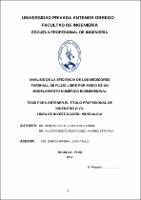Mostrar el registro sencillo del ítem
Análisis de la eficiencia de los medidores parshall de flujo libre por medio de un modelamiento numérico bidimensional
| dc.contributor.advisor | García Rivera, Juan Pablo | |
| dc.contributor.author | Rengifo Cruz, Giancarlo Andre | |
| dc.contributor.author | Vilcarromero Rodriguez, Andrea Stefania | |
| dc.creator | Rengifo Cruz, Giancarlo Andre | |
| dc.date.accessioned | 2019-10-01T14:12:40Z | |
| dc.date.available | 2019-10-01T14:12:40Z | |
| dc.date.issued | 2019 | |
| dc.identifier.uri | https://hdl.handle.net/20.500.12759/5492 | |
| dc.description.abstract | El objetivo de nuestra investigación es el análisis de la eficiencia de los medidores Parshall de flujo libre por medio de un modelamiento numérico bidimensional. Ante la importancia que representa tener hoy en día un buen control en el uso del agua, se analizara la eficiencia de los medidores Parshall de flujo libre para ver si estos están funcionando de una forma eficiente, estas estructuras hidráulicas tienen un diseño definido, debiendo tener mucha precisión en el proceso constructivo por lo que un error podría generar medidas equivocadas del caudal que circula por estos, también se le debe dar un constante mantenimiento para evitar la formación de vegetación que se forman a lo largo del tiempo. En primera instancia se adquirió datos en campo del valle de Chicama, y del valle Jequetepeque, asimismo se medió el caudal con Correntómetro, los datos obtenidos fueron registrados en la hoja de Excel denominada REGISTRO DE AFORO CON CORRENTOMETRO la cual se utiliza por la Juntas de usuarios para guardar estos datos. Luego se diseñaron medidores Parshall en 3D con el software AutoCAD para poder hacerle una simulación con el Software Iber, para que finalmente se realice la comparación de resultados entre los datos de diseño teórico de Ralph Parshall, el modelo IBER y los datos medidos por el correntómetro. | es_PE |
| dc.description.abstract | The objective of our research is the analysis of the efficiency of Parshall free flow meters by means of a two-dimensional numerical modeling. Given the importance of having a good control in the use of water today, we will analyze the efficiency of Parshall free flow meters to see if they are functioning efficiently, these hydraulic structures have a defined design, having to have much precision in the construction process so that an error could generate wrong measures of the flow flowing through these, also must be given a constant maintenance to avoid the formation of vegetation that are formed over time. In the first instance, data were acquired in the Chicama valley and Jequetepeque valley, and the flow rate was measured using a Correntometer. The data obtained were recorded in the Excel sheet called REGISTRO DE AFORO CON CORRENTOMETRO, which is used by the Boards of users to save this data. Then Parshall meters were designed in 3D with AutoCAD software to be able to simulate it with the Iber Software, so that finally the results comparison between the theoretical design data of Ralph Parshall, the IBER model and the data measured by the correntometer. | en_US |
| dc.description.uri | Tesis | es_PE |
| dc.format | application/pdf | es_PE |
| dc.language.iso | spa | es_PE |
| dc.publisher | Universidad Privada Antenor Orrego | es_PE |
| dc.relation.ispartofseries | T_ING.CIVIL_1452 | |
| dc.rights | info:eu-repo/semantics/openAccess | es_PE |
| dc.rights.uri | https://creativecommons.org/licenses/by/4.0/ | es_PE |
| dc.source | Universidad Privada Antenor Orrego | es_PE |
| dc.source | Repositorio Institucional - UPAO | es_PE |
| dc.subject | Parshall | es_PE |
| dc.subject | Medidores | es_PE |
| dc.title | Análisis de la eficiencia de los medidores parshall de flujo libre por medio de un modelamiento numérico bidimensional | es_PE |
| dc.type | info:eu-repo/semantics/bachelorThesis | es_PE |
| thesis.degree.level | Título Profesional | es_PE |
| thesis.degree.grantor | Universidad Privada Antenor Orrego. Facultad de Ingeniería | es_PE |
| thesis.degree.name | Ingeniero Civil | es_PE |
| thesis.degree.discipline | Ingeniería Civil | es_PE |
| dc.publisher.country | PE | es_PE |
Ficheros en el ítem
Este ítem aparece en la(s) siguiente(s) colección(es)
-
Ingeniería Civil [1149]


